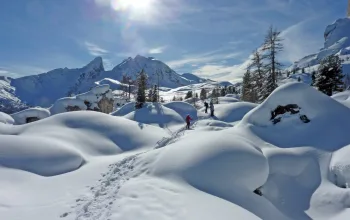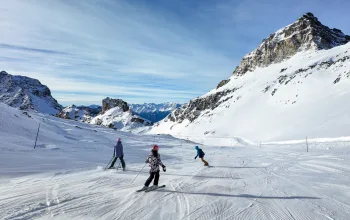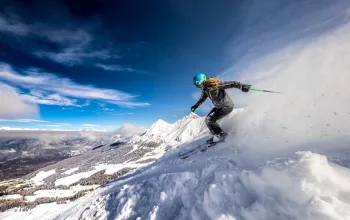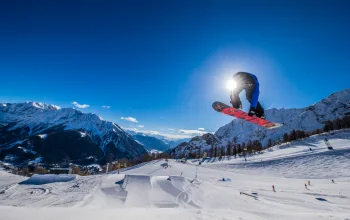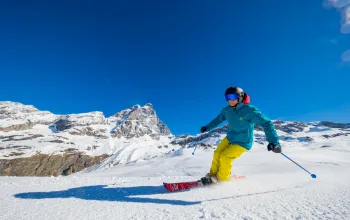Sagnalonga isn't a ski resort as such but a tiny hamlet centred on the Sport Hotel high up at 2000m in the Milky Way above Claviere and Cesana. The 'resort' is accessed by chairlift from Cesana or a snowmobile taxi from Claviere. The Sporthotel is well equipped with good amenities
Mountain
Sestrière is the central point of a vast trail network which extends over to Sauze d'Oulx and has a more tenuous connection via Sansicario, Cesana and Claviere over to Montgenèvre. In this immense area there is something for everyone, from beginners to experts. Sestrière's skiing has been well designed from the start. The vast snowy bowl, largely above the tree line, gave the planners a blank sheet to play with. Beginners runs fan out above the ski school meeting point in the resort' centre. and a special lift tickets given relevant limited lift access for beginners only is also available. Experts have fewer trails just for them but heli-skiing is popular in the area. Runs in the Amphitaeatro bowl and the blacks at the top of Sises and Motta are also highly regarded. Intermediates will enjoy Sestrières skiing the most, using the two main local areas of Banchetta and Sises. There are runs of all kinds from short steep moguls to long wide motorway cruisers. It's easy to get over to the pleasant wooded trails above neighbouring Sauze d'Oulx. The trails over to Montgenèvre can be tackled by intermediate skiers via blues and reds. It is an exciting trip as you have the feeling of travelling from village to village. A full day should be allowed and some sectors, notably around the village of Cesana may not have adequate snow cover except at the height of the season. A run good skiers should not miss in Sestriere is Mount Sises (which also gives access to excellent off piste from the slopes of Valle Ripa and Vallone del Chisonetto). This is the World Cup and World Championships giant slalom run. You reach the top (2600m) with the four passenger chair-lift Cit Roc and then a ski-lift. The run is steep but wide in the highest part then flatter around the Mount Alpette and becoming once again quite "vertical" under the chair lift where the old ski lift once passed. Sauze d'Oulx's ski area can be accessed from four different points around the village, all served by chair lifts and linked at resort level by a ski bus. As the resort is built on quite a steep hillside and all the lifts leave from the upper outskirts of the village, this bus is invaluable for many guests. Beginners have a village level nursery slope at the base of the Clotes chair, but most teaching takes place at Sportina, a plateau area half way up the mountain from which many lifts radiate out and there are a number of short beginner drags. Sportina can be reached quickly by a quad chairlift. Intermediates will get the most out of this great varied terrain and enjoy the feeling of travel over to the neighbouring areas. Reasonable intermediates can make the Milky Way link in reasonable snow conditions by skiing over to Sansicario, taking the chairlift link across the top of Cesana and then skiing on above Clavière, over the border to Montgenèvre in France. Remember to check ahead for piste conditions all the way over and leave early to be on the safe side. Expert skiers in Sauze will find some fun off-piste amongst the larch woods of the lower slopes or up in the higher powder bowls. There are a variety of off piste routes which a guide can show you that descend 1300m from the top of Fratieve to the valley. Montgenèvre's skiing marks the Western end of the Milky Way circuit; it's the only French resort on it. Skiing takes place on both sides of the main road that runs through the resort and over the pass into Italy. The area is most fun for intermediates who will enjoy the endless variety of trails above the treeline and then plunging down through the forest. Popular routes include the wide runs down from Les Angles at the top of the resort and the long red from Le Chavlet across the Valley. Beginners have wide sunny slopes by the village and, because of the altitude, backed up with snowmaking, the convenience of village level nursery slopes is ensured throughout the season - unlike at many other famous but lower altitude resorts. The altitude also means that Montgenèvre can genuinely maintain a sunshine record that is the envy of many, but doesn't melt too much of the snow. Experts may have to travel about to find a huge amount of challenging terrain, or venture off piste with a guide. Nonetheless there are seven marked black pistes at Montgenèvre alone. These are dotted all around the mountain, but the 'off the beaten track' Col de l'Alpet area on the 'back route' to Clavière 2430 metres is a favourite area for bumps. For heliskiing from Montgenèvre there are two drop off points on the Italian peaks over 3000 metres. In Sestriere its possibile to ski at night on the floodlit run where many ski champions have battled it out in World Cup competitions
Families
Generous free skiing is available for children aged up to 8 with the Vialattea Junior Card when purchased from 4 to 15 consecutive days. Children under 12 receive a discounted pass. There are also special low season package deals on accommodation and ticketing for families with older children. Sauze is one of the best centres for childcare in Italy, the Dumbo non-skiing daycare accepts children as young as newborn up to six years of age. The ski school has special classes for children aged five to ten. In Montgenevre daycare is offered in the Halte Garderie by the tourist office. The ski school runs a snow garden with its own baby lift. Children aged three to five can join the ski kindergarten.
Eating Out
Claviere has a small selection of restaurants serving traditional Italian food, most of them are based in the local hotels. For the best in gourmet food Il Gran Bouc is the place to be seen. Gallo Cedrone is another good choice and there are several pizzerias offering the first true Italian pizzas after you cross the border from France at high value prices
Apres
Claviere has a fairly limited apres ski scene with a handful of mostly hotel bars stretched along the main street. That doesn' man the nights can't b lively, prticulrly if you brave the Gallo Cedrone's karaoke bar. The Gran Bouc also as a popular bar. Other evening activities include the amusement arcade and, if it's cold enough, a natural ice rink.
Boarding
Snowboarding is a popular on the Via Lattea where fast new chairlifts have made moving around much easier. Sestriere has hosted Snowboard World Cups and Sauze d'Oulx has the party atmosphere. There are two snowparks - one at each end of the circuit in Montgenevre and in Sestriere. Montgenèvre's dedicated snowboard park above the resort, fenced off from the main terrain and designed for maximum air and to enable the best acrobatics. The local terrain offers good and varied free riding.



